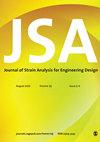Assessment of the degradation in mild structural steel using electron backscatter diffraction (EBSD) technique
IF 1.4
4区 工程技术
Q3 ENGINEERING, MECHANICAL
Journal of Strain Analysis for Engineering Design
Pub Date : 2021-12-03
DOI:10.1177/03093247211062684
引用次数: 0
Abstract
This paper reports the degradation assessment of mild steel during the plastic tensile process. The electron backscatter diffraction (EBSD) technique was adopted in this study. The orientation maps showed that with the increase of tensile strain, the grain surface become wrinkled, and the deviation level of intragranular orientation also increased. Meanwhile, the parameters based on the image quality of the Kikuchi bands (i.e. BC and MAD) as well as the crystallographic orientation (i.e. LAGBs content, GND density, GOS, and GROD) can be used to evaluate the degradation degree of the mild steel. The results showed that the change of BC and MAD was significant at the end of plastic stage, but was not sufficiently distinctive at the early stage; Meanwhile, the LAGBs content and GND density increased evidently during the plastic tensile. Compared with the former, the GND density exhibited stronger regularity and better evaluation effect; Besides, a general upward trend of GOS and GROD was observed at this tensile process. However, the GROD changed less at the certain plastic stage. Compared with GROD, the GOS exhibited a relatively better evaluation effect; To sum up, the GND density and GOS are the better indicators for evaluating the degradation degree of mild steel.用电子背散射衍射(EBSD)技术评价弱结构钢的降解
本文报道了低碳钢在塑性拉伸过程中的退化评价。本研究采用电子背散射衍射(EBSD)技术。取向图显示,随着拉伸应变的增大,晶粒表面起皱,晶粒内取向偏差程度增大。同时,基于Kikuchi波段图像质量(即BC和MAD)和结晶取向(即LAGBs含量、GND密度、GOS和GROD)的参数可以用来评价低碳钢的降解程度。结果表明:BC和MAD在塑化后期变化显著,但在塑化前期变化不明显;同时,在塑性拉伸过程中,LAGBs含量和GND密度明显增加。与前者相比,GND密度具有更强的规律性和更好的评价效果;在拉伸过程中,GOS和GROD总体呈上升趋势。而在一定塑性阶段,GROD变化较小。与GROD相比,GOS的评价效果相对较好;综上所述,GND密度和GOS是评价低碳钢降解程度的较好指标。
本文章由计算机程序翻译,如有差异,请以英文原文为准。
求助全文
约1分钟内获得全文
求助全文
来源期刊

Journal of Strain Analysis for Engineering Design
工程技术-材料科学:表征与测试
CiteScore
3.50
自引率
6.20%
发文量
25
审稿时长
>12 weeks
期刊介绍:
The Journal of Strain Analysis for Engineering Design provides a forum for work relating to the measurement and analysis of strain that is appropriate to engineering design and practice.
"Since launching in 1965, The Journal of Strain Analysis has been a collegiate effort, dedicated to providing exemplary service to our authors. We welcome contributions related to analytical, experimental, and numerical techniques for the analysis and/or measurement of stress and/or strain, or studies of relevant material properties and failure modes. Our international Editorial Board contains experts in all of these fields and is keen to encourage papers on novel techniques and innovative applications." Professor Eann Patterson - University of Liverpool, UK
This journal is a member of the Committee on Publication Ethics (COPE).
 求助内容:
求助内容: 应助结果提醒方式:
应助结果提醒方式:


